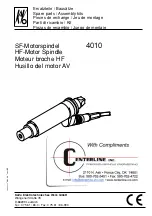
MAESTRO 2-S
TROUBLE SHOOTING
WIND SPEED
WIND DIRECTION
1.
Disconnect the two wind-speed wires from the back of the brass read-out.
2.
Attach a low range AC Analog Voltmeter to the wires. If the speed sensor is operating properly, you will
achieve these approximate readings: 8-9 MPH = 0.28 VAC rms, 17 MPH = 0.56 VAC rms,
51 MPH = 1.78 VAC rms, 102 MPH 3.67 VAC rms
3.
If the speed sensor delivers these approximate readings, then the brass read-out is faulty. If the speed
sensor does not produce these readings, then either the speed sensor or the wire is faulty.
1.
Unplug the AC Power Adaptor.
2.
Disconnect the AC Adaptor wires and the 5-conductor cable wires from the bac of the brass read-out.
3.
Connect an AC Voltmeter to the two wires coming from the AC Power Adaptor.
4.
Plug in the AC Power Adaptor to a 110 VAC outlet. When functioning properly, the adaptor will deliver
11.5-18 VAC. If the adaptor checks out fine, proceed further with the test. If not, send both the adaptor
and the instrument to Maximum.
5.
If the AC Adaptor checks okay, unplug the Adapter and re-connect the two wire to the back of the
brass read-out.
6.
Plug in the AC Power Adapter.
7.
Using a small piece of wire or a paper clip as a jumper, touch one end to terminal #3 (the middle one of
the five). Touch the other end to terminal #1, then #2, then #4 and lastly #5 (keeping one end of the
jumper on terminal #3). At each termial, two adjacent lights should light up simultaneously. If any light
fails to function properly, the fault lies within the brass read-out.
8.
If all the lights function properly, then the problem lies with either the wiring or with the outdoor wind
direction sensor. Disconnect the wires at the sensor and bring it down to the brass read-out.
9.
Use a short piece of the 5-wire cable and reconnect the sensor to the brass readout as shown in the
installation instructions.
10.
Rotate the vane slowly by hand and observe the lights on the brass read-out. If they operate properly,
then the installed wiring is at fault; if not, then the outdoor wind direction sensor is faulty.
Maximum Instruments are accurate and reliable. Most problems that occure are due to loose or corroded
connections. If, after checking the connections, there is still a problem, determine if the problem is with the
sensor or the brass read-out.
1.888.610.7664
Fluke
-
Direct
.com
























